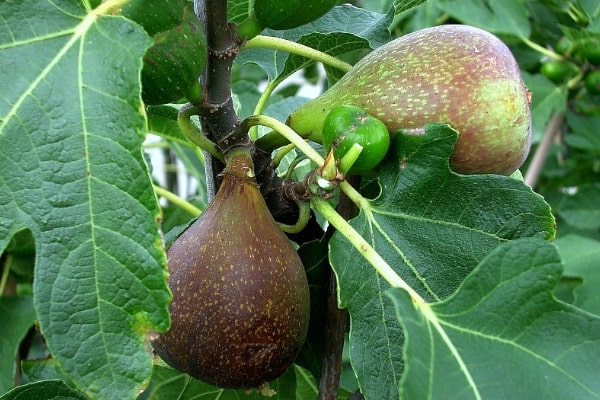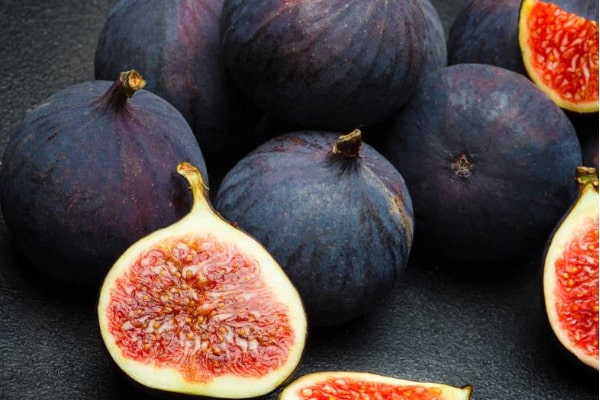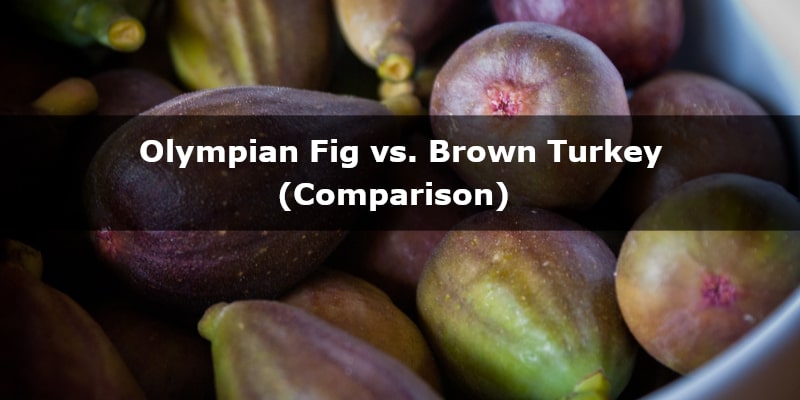Figs bear abundant fruit. They are low-maintenance plants that can be grown in your home gardens conveniently. But did you know fig trees have more than 700 identified types?
Due to numerous options, choosing a variety for your garden can be confusing.
In this article, I will compare two of the best fig varieties to help you make a better decision. So, here is the detailed Olympian fig vs. Brown Turkey analysis and comparison.
Olympian Fig: at a Glance
Olympian Fig is a variety that produces large purple-colored figs which are deliciously sweet. The average height of an Olympian fig tree is 8-15 feet (2.4-4.6 meters) tall.

First discovered in Washington State, the Olympian fig is an award-winning, ultracold hardy variety. It is one of the few figs that can withstand extremely cold temperatures.
In addition, it is a fast-growing and self-pollinating tree that requires minimal upkeep.
Brown Turkey Fig: at a Glance
Brown Turkey figs are dark brown-purple in color when ripe and have a moderately sweet flavor. Since they are tiny trees or large shrubs, you can expect them to grow to 10 to 30 feet (3.1-9.2 meters) on average.

Brown Turkey belongs to the Moraceae family. It is one of the widely grown fig varieties in the US. Like Olympian figs, Brown Turkey is also self-pollinating, fast-growing, and low maintenance.
Taste, Texture, Color
Olympian figs are juicy and super sweet. These fruits are green before ripening. After maturing, they develop delicate purple outer skin and a violet flesh that tastes incredible. They are round in shape and have a nice, firm appearance and chewy texture.
On the other hand;
Brown Turkey figs, are less sweet and milder in flavor. These figs are dark brownish purple from the outside and orangish pink from the inside. They feel solid when you touch them and have a soft texture.
Fruit Size
Both Olympian and Brown Turkey figs are 2-4 inches (5-10 centimeters) long as it is the average fruit size of a fig. Olympian figs tend to be slightly larger than Brown turkey figs.
Nutritional Value and Health Benefits
Along with natural sweetness, figs provide fantastic nutritional value. Olympian and Brown Turkey figs are decent sources of fiber, antioxidants, magnesium, and potassium. Both varieties also contain carbohydrates, sugar, vitamins, a small amount of protein, and fats.
Many cultures associate figs with good health. They offer multiple health benefits, such as helping with constipation, preventing cell damage, and minimizing the risk for chronic illnesses.
The high fiber content of dried figs can help relieve constipation and promote a smooth bowel movement.
They also contain antioxidants that can prevent cell damage caused by environmental toxins like cigarette smoke and polluted air.
Antioxidants are also considered to lower the chances of long-term diseases like Alzheimer’s, diabetes, eye diseases, and more. However, it is important to note that this correlation is still not fully understood by experts.
Related: Black Genoa vs. Brown Turkey Fig (Comparison)
Price
Depending on the size, Olympian figs can be bought from online retailers for prices ranging from $32.99 to $79.95. While on the other hand, Brown Turkey figs can be purchased for between $29.99 and $109.95.
You can also save money if you decide to buy from a nearby nursery. Or you can also check out Amazon for live Olympian and Brown Turkey fig plant options for much cheaper rates. You can buy them for around $13.99-$20.
The Brown Turkey fig tree is available for varying rates in the market. The price of a 2-3 feet (60-90 centimeters) high tree is between $29.99 and $32.99. Meanwhile, taller trees are between $54.97 and 109.95.
Tree Appearance
Olympian figs grow on 8–15 feet (2.3-4.5 meters) tall trees. These trees have lush green and tropical-looking leaves bringing a dramatic touch to your landscape. There are also tiny flowers, but they’re hidden by the foliage, so you can’t see them.
On the other hand;
Brown Turkey also has gorgeous green foliage in spring and summer, but it turns paler in fall. The average height of a Brown Turkey fig tree is between 15-30 feet (4.5-9.1meters).
Both trees yield green figs that mature to deeper purple color.
Feeding
The watering needs of fig plants are moderate. You can water them 2-3 times a week when they are young. After maturing, they are good with 1-1.5 inches (2-3 centimeters) of water.
This quantity is sufficient for the plant as it enables the ground to store some moisture until the subsequent watering.
When it comes to containerized figs, their placement can be adjusted as the season progresses. Also, don’t forget to keep a check on their watering needs, as their root level should stay moist.
When it comes to fertilization, fig trees don’t require it very often. However, it will be necessary to apply nitrogen supplements to your plants if their growth is a little too slow. Nitrogen is imperative for plant growth because it is a main component of chlorophyll and amino acids.
So, if your tree is developing less than 10-12 inches (25-30 centimeters) in a growing season, add half a pound of nitrogen supplement to its base.
Since Olympian and Brown Turkey are self-fertile, they don’t need a pollinator to produce fruit. So, you don’t have to worry about it.
Related: The Top 3 Largest Fig Varieties (with Photos)
Tree Maintenance and Care
Just like all fig trees, Olympian and Brown Turkey figs need 6-7 hours of proper sunlight in the growing season.
Olympian and Brown Turkey figs can flourish in a variety of soils. All you need is to ensure that soil is well drained as it can’t stand excessively wet ground.
To improve the quality of your soil and plants, you can spread thick mulch layers around their root system. Mulching adds texture and nutrients to the soil that might help your plants grow more quickly.
Harvesting
Both fig trees produce two crops a year. Their fruits can be harvested once in July and later in September.
Both types of figs can continue ripening after they’re picked, so it’s best to wait until they’re slightly soft to the touch before harvesting.
To pick a ripe fig, simply twist it gently until it comes off the stem. Once you’ve harvested your figs, they’ll keep for a few days at room temperature or up to a week in the fridge.
Enjoy them fresh, or use them in recipes like Fig and Blue Cheese Salad or Grilled Fig and Prosciutto Pizza.
Olympian Fig: Pros and Cons
Pros
- Extremely cold hardy
- Produces two crops in one year
- Pleasantly juicy and sweet
- Nutritious and beneficial for health
- Self-pollinating
- Easy to grow
Cons
- Figs are high glycemic fruits with a GI value of 61.
- Foods with a high glycemic index can raise blood sugar levels. Although the fig’s glycemic score is moderate, precaution is necessary.
Brown Turkey Fig: Pros and Cons
Pros
- Self-fertile
- Self-pollinating
- Grow quickly
- Easy to maintain
- Sweet and gorgeous looking
- Nutritious and healthy
- Perfect for snacking
- Yields two crops a year
Cons
- Brown turkey figs can cause diarrhea due to their anti-constipation nature
- Some people can be allergic to figs
Olympian Fig vs. Brown Turkey: Which Variety Should You Plant
You should choose Olympian figs over Brown Turkey anytime. Its ultra-sweet taste will perfectly complement your desserts, jams, juices, etc. Plus, its average height is smaller than the Brown Turkey tree, which makes it easier to maintain.
Olympian and Brown Turkey figs are not very different when it comes to their growth, feeding, and nourishment. Both trees are low maintenance and tend to grow up quickly.
However, you will have to choose the best possible fig variety for your garden. As a home gardener, you must prefer figs that are sweeter, and can be used in your food dishes.
You need a plant that produces abundant fruits that taste heavenly. And this is why, my fellow gardeners, you should choose Olympian figs over Brown Turkey.
Lastly, the Olympian fig is extremely cold tolerant. It will reappear from the roots at lower temperatures down to 0°F (-17°C). Consequently, Olympian figs are a great choice if you live in a colder region.
References:
Territorialseed.com, starkbros.com, onegreenworld.com, fast-growing-trees.com, greenthumbsgarden.com, everglades.farm,prudentreviews.com, naturehills.com, Thisoldhouse.com, cropnutrition.com, phoslab.com, verywellfit.com, hsph.harvard.edu

